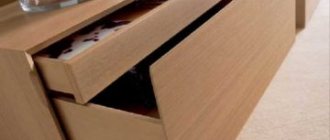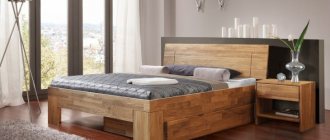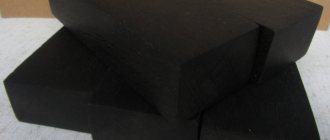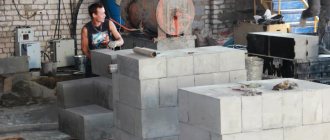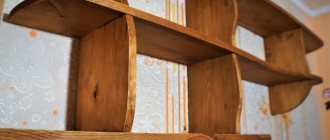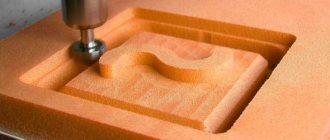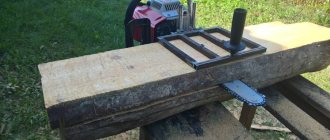Painting chipboard and fiberboard is a responsible procedure that requires compliance with certain rules. For work, certain compositions are used to achieve optimal results. Due to its structure, the material absorbs the applied solution well, so careful preparation is required. The place where the slabs are used is also important, as this involves different levels of exposure.
In what cases should chipboard be painted?
The main reason for decorating a board made of shavings is its unpresentable appearance. Untreated products look rough, and sawdust is not visible under the paint.
Expert opinion
Zakharova Irina Yurievna
Cleaning professional with 15 years of experience. Our best expert.
Ask a Question
Particle boards quickly become covered with chips and chips. The paint protects the surface from mechanical damage, increases its resistance to moisture and prevents the evaporation of formaldehyde.
Furniture doors and drawers made from unfinished chipboard will warp over time. Painted boards are less susceptible to warping, especially if they are additionally coated with varnish.
Features of laminated chipboard
The main difference between laminated chipboard and a simple panel is its outer surface, which can consist of laminated paper or PVC film. Thanks to this protection, the board is not afraid of exposure to moisture or direct contact with water, and is also resistant to mechanical damage.
But in order to paint laminated chipboard, you need to follow a number of rules. For example, when sanding a finish, if you overdo it, you can remove the laminate completely, which will lead to the destruction of the cabinet door. It will have to be completely changed or the coating restored by pasting it with a special film. You don’t have to sand it or remove the top layer, but thoroughly wash the chipboard and paint it with paints that are specially designed for complex varnished surfaces.
Rules for choosing the right paint
When planning the painting result, consider the following points:
- ease of use;
- area to be painted;
- desired color.
Small chipboard products are easy to paint with a spray can and brush, so aerosol or can paint is suitable for the job. It is convenient to go over large surfaces with a roller. In addition to color, you need to choose what the surface should be like:
- glossy;
- matte;
- tinted.
The color can be single or combined. For multi-colored dyeing, you should choose a harmonious combination of shades, look for colors in the line of one manufacturer, or choose a tone for coloring. When choosing a primer and paint, it is better to choose formulations of the same brand and on the same base - water-based, latex, acrylic.
Choosing a color
Color palette
Painting chipboard furniture opens up the broadest horizons for your imagination and creative potential.
Depending on your wishes, coloring can be:
- Plain:
- Two-color;
- Multi-colored.
For single-color painting, you can create the desired shade yourself by mixing several colors of acrylic paint from one manufacturer or adding color to the paint.
In order to create clear contours in two-color and multi-color painting, you should use masking tape.
Advice. Applying each subsequent layer of paint must be done only after the previous one has completely dried.
Stages of dyeing at home
In order for the coating to last for a long time, it is important to properly prepare the surface of the particle board.
Required tools and materials
To work you will need:
- narrow brush - for painting corners and ends;
- foam rollers - for priming and painting facades;
- masking tape - to protect permanent fittings and elements painted in a different color;
- sandpaper - coarse and fine.
When painting chipboard, it is recommended to pour the paint into a ditch for rolling out the roller for better absorption of the composition. As a result, the color will be even and the coating will have no gaps.
In addition to paint, the following materials are used in the work:
- primer;
- alcohol;
- solvent;
- varnish
Use a solvent to remove old paint, and degrease the surface with alcohol. You may also need putty to cover deep chips and a spatula.
Surface preparation steps
Chipboard furniture is disassembled before painting. The fittings are removed, and the stationary parts are sealed with masking tape. The surface is then prepared for painting.
Alignment
The relief surface is smoothed with coarse sandpaper. The rough sheet is moved sweepingly along the fibers. Use the same method to remove old paint. Rubbing with sandpaper will cause the surface to become covered with dust. Small particles are brushed off with a dry paint brush. Wood dust cannot be removed with a damp cloth. Debris will stick to the wet board. It will be impossible to remove it, and the surface will have to be leveled again.
Skinning
At the next stage, the board is sanded with fine-grained sandpaper. Dust is also cleaned off with a dry brush.
Cleaning and degreasing
A smooth, sanded board without dust is wiped with a damp cloth and then dried with a dry cloth.
For better adhesion to the primer, the surface is degreased and wiped with alcohol.
Surface priming
Damaged boards with cracks are repaired with putty. The primer is applied with a roller or brush in a thin layer. Before painting the product in dark colors, you need to apply primer in two layers. The completely dry board is ready for painting.
Chipboard painting technology: step-by-step instructions
How to repaint old furniture:
- to take apart;
- remove the fittings;
- cover the permanent decor with masking tape;
- remove old paint with a sanding machine or solvent;
- prepare the surface by leveling, sanding and priming;
- Apply paint with a roller or brush.
See also
How and with what you can paint a refrigerator with your own hands at home
It is recommended to lay the board horizontally, since in a vertical position the composition will spread. Particleboard partitions begin to be painted on top. You need to paint in at least 2 layers. New chipboards are painted in the same way, skipping the removal of the old paint.
To give the surface texture, rollers with synthetic long pile are used. Applying the paint with a short-haired roller will result in a smooth surface.
Before final painting with acrylic paint, it is recommended to practice on a “draft”—trimming the board. The sample is prepared in the same way as the main surface and the tone is applied. The inspection will help you evaluate the color and appearance of the paint on the furniture.
High-quality painting of interior doors: tips from a painter
Every theater begins with a hanger, and the interior of any room begins with a door, which sets the mood and makes a significant contribution to the atmosphere of the interior and is an important element of the zoning of the room.
Many people who have started renovations underestimate the need to update interior doors, focusing on the choice of wallpaper, flooring and furniture. As a result, an unpleasant contrast is created between a brand new room and an old door that has lost its appearance
But this can be avoided if you paint the interior doors yourself. Provided that the paint is selected correctly and the painting technology is followed, the result will be excellent, which will allow you to create a complete, harmonious interior and at the same time significantly save money.
Rules for applying varnish with your own hands
Wood chips and resin have different absorbent properties. When decorative compounds are applied to clean chipboard, a non-uniform color is obtained. The primer promotes uniform distribution of the coating. Therefore, the main rule for varnishing particle boards is mandatory priming.
How to varnish chipboard:
- the cleaned surface is coated with a primer;
- polish;
- apply the first layer of varnish;
- after complete drying, sand again;
- coated with a second layer of varnish;
- finally level the dried surface.
The varnish is applied with a brush, and for a more uniform coating, a cotton swab with cotton filler is used. When applied with a swab, the composition saturates the surface well.
Necessary materials
In addition to tools, you will need painting materials, which include solvent, primer, paint and putty.
The solvent is needed to remove old paint or varnish, if we are talking about used furniture, as well as to degrease the surface before painting. A primer will be needed to level the panel and impregnate it, which will prevent excess paint absorption into the chipboard and help create a more even layer.
Painting cannot occur without the use of paints and varnishes. To restore the coating, you can use acrylic or water-based enamel. Both types of paint have their advantages, for example, acrylic is considered quick-drying and allows you to complete the work in a short time.
You may need putty to smooth out chips and scratches. This material is sold in a ready-to-use form and upon contact with a wooden surface it thickens and forms a monolithic coating. There are also dry putty materials that need to be diluted.
In addition to the listed painting materials, there are also many different additives and varnishes that improve the properties of the paintwork, which increases its service life.
Options for subsequent decoration
Original ways to design furniture from chipboard:
- two-color painting: front surfaces white, and side surfaces black, light green, yellow, red;
- antique effect: add a darker, well-diluted shade to the painted surface;
- pasting with colored film: decorate the doors of a cabinet or chest of drawers with a floral pattern, an abstract pattern;
- drawings using stencils: ornaments and flowers are applied on top of the main tone in a contrasting color.
Aerosol paint is also used for decoration. With their help, they create the effect of ombre and chrome plating. Walls and partitions are covered with wallpaper over paint.
What is chipboard: composition, production method and types of particle boards
Chipboard stands for particle board. This material is made from sawdust, which is filled with a hot adhesive based on a mixture of natural and synthetic resins. The resulting mixture is rolled out on a special machine into flat sheets of different thicknesses.
The particle board is covered with a layer of varnish or polyvinyl chloride (PVC) film. It is used for finishing walls, upholstered furniture frames, and cabinet furniture facades. There are several types of chipboard:
- Simple stove. This material is not treated with any coatings. It is used in construction and in furniture manufacturing: rough parts are made from such sheets.
- Laminated chipboard. It is covered with a film that makes it look like natural wood. There are two main types of laminated plates - laminated and tongue-and-groove. The latter are much more expensive and are used to make wall panels.
Aftercare rules
How to extend the service life of painted furniture and chipboard structures:
- do not install in direct sunlight or near heating devices;
- do not place dishes with hot drinks and dishes on the countertop, use mats;
- before transportation, pack in cardboard boxes, wrap the corners with newspaper;
- clean surfaces from dirt with a slightly damp cloth, you can use a soap solution;
- do not rub with a hard brush or metal sponge;
- Do not clean with abrasives or household chemicals containing chlorine.
If the coating is cracked, do not allow moisture to enter the crack.
